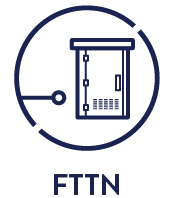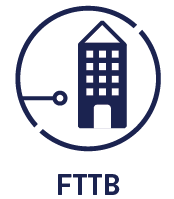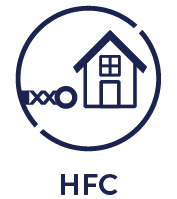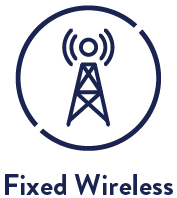nbn® speeds explained
Many factors can influence your nbn® Internet speed - it can be complicated. To help you navigate the complexity and select the plan that best suits your needs, we’ve simplified some key information for you:
Many factors can influence your nbn® Internet speed - it can be complicated. To help you navigate the complexity and select the plan that best suits your needs, we’ve simplified some key information for you:
nbn co ltd is building and maintaining the National Broadband Access Network across Australia. The maximum line speed is determined by the type of technology that nbn co ltd has installed up to, and on, your premises. Listed below are the various technology types. Regardless of which service provider you choose, this remains the same.
 |
Fibre to the premises (FTTP)Fibre cable directly to your premises (replacing all existing copper cables). |
 |
Fibre to the Node (FTTN)^Fibre to a node in your street, then via the existing copper network straight into your premises. |
 |
Fibre to the Building (FTTB)^Fibre to the basement of your building, and then via the existing technology in the building to connect to each office. |
 |
Hybrid Coaxial Fibre (HFC)Combination of new and existing cables from the fibre node to your premises. |
|
|
Fibre to the Curb (FTTC)^Fibre extended to a small Distribution Point Unit (DPU) close to your premises (usually inside a pit on the street) then via the existing copper network to your premises. |
 |
Fixed WirelessData is delivered wirelessly via radio signals from a fixed wireless transmission tower to an nbn approved antenna on the roof of your premises. |
^ Additional factors apply to technologies using existing copper cable, which may reduce speeds. These may include but are not confined to; The length of the copper cable from the node to your wall socket, the condition of the copper, and/or exposure to the elements. Co-existence is another factor: this is the minimum period of 18 months after an area becomes ‘ready for service’ (RFS) and may be extended by nbn® if required. RFS is not specific to any individual service but applies to the entire area in which existing DSL and traditional analogue telephone (PSTN) services co-exist with nbn FTTB/N/C services.
We are constantly improving and updating our network in order to deliver the best possible Internet experience for you. Vocus Group connects to 121 Point of Interconnects (POIs). Along with this continued investment in infrastructure, our teams work constantly to optimise the network, so you can enjoy the benefits of a super-fast broadband service. Although we make every effort to maintain consistency, there may occasionally be congestion during peak times, which may affect your experience. Rest assured that we are constantly working to improve this and always monitoring our AVC/CVC for required upgrades.
Commander offers all kinds of speed tiers for different business needs. The speed that best suits your business depends on your type of nbn® technology connection, your business operations, the purpose of your Internet usage and the minimum line speed of your nbn™ connection.
nbn® speed tier |
Technology |
Suitable for |
|---|---|---|
Standard Plus (50/20) |
|
|
Fixed Wireless Plus (100/20) |
|
|
Premium (100/40) |
|
|
Superfast (250/25) |
|
|
Ultrafast (1000/50) |
|
|
Superfast (250/100) |
|
|
Superfast II (500/200) |
|
|
Ultrafast (1000/400) |
|
|
nbn® speed tiers refer to the wholesale speed tiers provided to us by nbn®. These speed tiers have theoretical maximum attainable download speeds of Standard Plus & FW+ 50 & 100 Mbps respectively, Premium 100 Mbps, Superfast 250 Mbps, Superfast II 500 Mbps and Ultrafast 1000 Mbps outside of peak hours. It’s unlikely that you will experience these speeds. The actual speeds that you experience may be slower than the theoretical maximum for your technology type and speed tier due to factors such as the quality and layout of copper wiring forming part of your connection and electrical interference. For Fixed Wireless factors may differ, signal strength or obstruction to line of sight, weather conditions like extreme heat and heavy rain or the capacity and the demand on the nbn Fixed Wireless tower and network. Commander relies on nbn co ltd to provide information on congestion on Fixed Wireless services. For FTTB, FTTC & FTTN customers, until your service is connected, we are unable to confirm your maximum attainable speed. If your line does not support your chosen speed tier, we will inform you and offer to change your speed tier or terminate your service.
Please also refer to the nbn® Fixed Line Key Fact Sheet or the nbn® Fixed Wireless Key Fact Sheet.
A Modem/Router/Gateway is an electronic device that enables transmission of data to, or from, a computer via telephone or other communication line. It is important you set up a quality device as your modem to the Internet. All Commander Business Modems are pre-tested, sourced from reputable manufacturers, and will withstand the requirements essential to providing a great Internet experience.
If there are multiple users in your business who rely on uploading, downloading and streaming large files (such as high definition videos) simultaneously, your Internet experience may be occasionally affected. If you notice this makes an ongoing impact on your service, please speak to us about a higher connection tier.
This is not a myth. Mobile phones, microwaves and even television signals can interfere with your Wi-Fi. Placing your modem or router in a spot away from these devices will help minimise interference.
If your internal cabling is damaged, badly connected, configured poorly or corroded, it may impact your nbn® experience. Our technicians can assist you with any installation and technical requirements like these - just contact us if you would like to discuss this option. (Charges may apply)
In most cases, nbn services will not function during a power failure, this means you are unable to make or receive calls. This service may not be appropriate if you require an uninterrupted phone service with access to 000 emergency services.